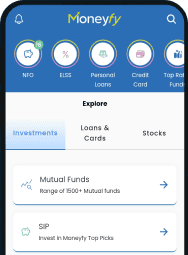NFO Mutual Funds
Invest in New Fund Offers; the first time subscription offer for a new scheme launched by the Asset Management Companies (AMCs)
Min Investment
₹ 100.0
Open Date
28 Oct, 2025
Close Date
11 Nov, 2025
Min Investment
₹ 500.0
Open Date
28 Oct, 2025
Close Date
11 Nov, 2025
Min Investment
₹ 200.0
Open Date
31 Oct, 2025
Close Date
14 Nov, 2025
Min Investment
₹ 500.0
Opening Date
14 Nov, 2025
Count Down
8 Days left
Min Investment
₹ 99.0
Opening Date
17 Nov, 2025
Count Down
11 Days left
Min Investment
₹ 500.0
Opening Date
10 Nov, 2025
Count Down
4 Days left
Min Investment
₹ 100.0
Opening Date
10 Nov, 2025
Count Down
4 Days left
Min Investment
₹ 0.0
Opening Date
21 Nov, 2025
Count Down
15 Days left
Min Investment
₹ 0.0
Opening Date
10 Nov, 2025
Count Down
4 Days left
Min Investment
₹ 100.0
Opening Date
07 Nov, 2025
Count Down
1 Days left
Min Investment
₹ 500.0
Opening Date
06 Nov, 2025
Count Down
0 Days left
Min Investment
₹ 500.0
Opening Date
10 Nov, 2025
Count Down
4 Days left
What is an NFO Mutual Fund?
A New Fund Offering (NFO) is when an asset management company (AMC) introduces a fresh mutual fund to gather capital. Investors can purchase units at a base price, typically Rs. 10 per unit. Much like an Initial Public Offering, an NFO lets you invest in a new fund before it hits the market. It’s a great opportunity to diversify your portfolio with innovative investment options and tap into future growth. NFOs can be open-ended, allowing you to invest or redeem anytime, or close-ended with a lock-in period. Managed by professionals, NFOs offer flexibility and can align with your financial goals.
How Does a New Fund Offering Work?
An NFO is the launch of a new mutual fund scheme offered by an Asset Management Company to investors for the first time. Its primary objective is to collect initial capital from investors, allowing the fund manager to create a portfolio aligned with the fund’s investment goals. During the subscription window, investors can apply for units at a fixed price, typically Rs.10, similar to an Initial Public Offering (IPO). After the NFO closes, the mutual fund is listed, and units are traded at market prices.
Types of New Fund Offers
NFOs provide a great opportunity for investors to enter a fund at an early stage. There are three main types of NFOs-
- Open-Ended NFOs: Based on the NAV, these funds allow investors to subscribe and redeem units at any time. After the NFO period, investors can continue investing either through lump-sum payments or SIPs. This type of NFO provides flexibility and liquidity, making it ideal for long-term investors seeking regular opportunities to invest.
- Close-Ended NFOs: In close-ended funds, subscriptions are only available during the NFO period. Once it ends, no further investments can be made. These funds are locked in for a specific duration, offering limited liquidity. However, they are listed on stock exchanges, allowing investors to trade units during the fund’s tenure. These funds are suitable for those seeking stable returns over a fixed period.
- Interval NFOs: Interval funds combine the features of close-ended and open-ended schemes. Investors can buy or sell units only during predetermined intervals, which may be quarterly, semi-annually, or annually. Between these periods, the fund functions like a close-ended fund. These funds are designed for investors who need some liquidity but are comfortable with restricted access.
Benefits of Investing in an NFO
Investing in an NFO presents several advantages that can enhance your portfolio:
- Low entry price: NFOs are typically offered at a nominal price, usually Rs. 10 per unit. This allows you to acquire more units at the start, potentially leading to higher returns as the fund grows over time.
- Potential for early gains: By investing early, investors can benefit from the fund’s initial growth phase, especially if it gains traction in the market. Being part of a fund from its inception may result in early gains before it becomes widely popular.
- Experienced fund management: NFOs are usually managed by experienced fund managers who bring valuable expertise in portfolio management. This professional management benefits investors, as fund managers select and manage assets in line with the fund’s objectives.
- Diversification: One of the main advantages of investing in an NFO is that it helps you diversify your portfolio. By investing in an NFO, you can spread your investments across various asset classes, reducing overall investment risks.
- Innovative investment strategies: NFOs often introduce new themes and investment strategies that are not available in existing mutual funds. This offers an opportunity to diversify your portfolio with fresh ideas and emerging sectors.
Things to Consider Before Investing in an NFO
Before investing in an NFO, you must consider the following factors-
- Track record : Unlike established mutual funds, NFOs lack historical performance data, making it harder to assess how the fund might perform in different market conditions. This adds an element of uncertainty for investors.
- AMC reputation: The credibility of the Asset Management Company is critical. Opt for NFOs launched by well-established AMCs with a strong track record in fund management.
- Liquidity : Check whether the fund is open-ended or close-ended. Open-ended funds offer higher liquidity as you can buy or sell units anytime after the NFO, whereas close-ended funds lock your investment for a fixed period.
- Costs and expense ratios : NFOs may have higher ongoing management fees compared to established funds. While the entry price may be low, high expense ratios can erode returns over time. Review these costs carefully.
- Fund objectives and strategy: It’s important to evaluate the NFO's objectives and whether they align with your investment goals. Some NFOs target high-risk sectors like small-cap equities, while others may focus on conservative assets. Make sure the strategy fits your risk tolerance and financial timeline.
- Market timing : NFOs are often launched during favourable market phases, but this doesn’t guarantee future performance. Assess the market environment carefully to avoid investing at a peak.
- Exit loads and lock-in periods: Some NFOs impose exit loads or lock-in periods, limiting your ability to withdraw funds. Make sure these terms align with your liquidity needs.
How to Invest in NFO with Tata Moneyfy?
Here’s how to invest in NFO through Tata Capital Moneyfy-
Step 1- Start by downloading the Moneyfy app onto your device.
Step 2- Review top-performing mutual funds and choose the schemes that suit your investment goals.
Step 3- Use the built-in calculators to plan your financial growth.
Step 4- Invest in New Fund Offers (NFOs) from a range of asset management companies.
Step 5- Monitor your investments easily with the user-friendly portfolio tracker.
FAQs on NFO Mutual Fund
view allHow to apply for a New Fund Offering in India?
What is the difference between an NFO and an IPO?
Is NFO taxable?
Like other mutual funds, NFOs are also taxable. If the equity allocation exceeds 65%, short-term capital gains (STCG) are taxed at 15%. Long-term capital gains (LTCG) up to ₹1 lakh are exempt from tax, but gains beyond this limit are taxed at 10%.
How to choose the right NFO mutual fund?
To select the right NFO, evaluate the fund's objectives, the AMC's reputation, the fund manager’s track record, and the expense ratio. Ensure the NFO aligns with your risk tolerance and investment goals, and compare it with existing funds before deciding.
How is NFO NAV calculated?
The NAV of an NFO is calculated by dividing the total value of the fund’s assets by the number of units issued. Initially, the NAV is set at Rs. 10 and then fluctuates based on the performance of the fund’s underlying assets.
What is the maximum period of NFO?
An NFO usually stays open for a few days to a few weeks, depending on the AMC’s decision. Once this period ends, new investments aren’t accepted until the fund becomes available through regular purchase options, if applicable.
How is NAV calculated for NFO?
In an NFO, the NAV is worked out by dividing the fund’s total assets (after subtracting any liabilities) by the number of units. It generally starts at a base value, often set at INR 10 per unit during the offer period.
Can I cancel NFO?
You can usually cancel your investment during the NFO period. After allotment, if it’s an open-ended fund, you may exit anytime. For close-ended funds, you’ll need to wait until the fund reaches its maturity.









